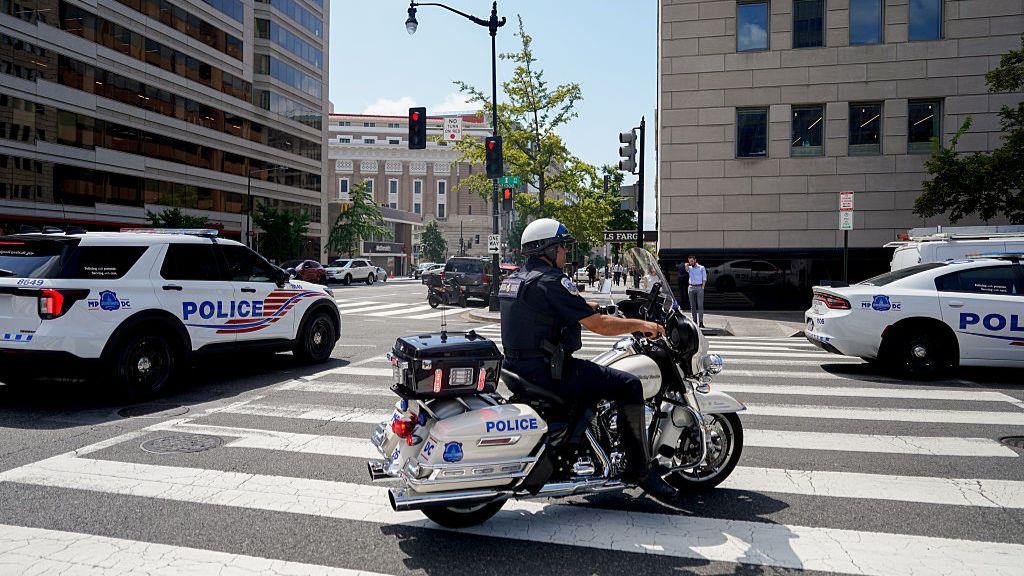Report on Crime Statistics in Washington D.C. and Alignment with Sustainable Development Goals
This report analyzes recent claims regarding a crime emergency in Washington D.C. by examining official data through the framework of the United Nations Sustainable Development Goals (SDGs). The analysis places particular emphasis on SDG 16 (Peace, Justice and Strong Institutions) and SDG 11 (Sustainable Cities and Communities), evaluating the city’s progress toward creating a safe, just, and sustainable environment for its residents.
Assessment of Violent Crime Trends Against SDG 16: Peace, Justice and Strong Institutions
Progress Towards Reducing Violence (SDG Target 16.1)
SDG Target 16.1 aims to “significantly reduce all forms of violence and related death rates everywhere.” An evaluation of recent data from Washington D.C.’s Metropolitan Police Department (MPDC) indicates a positive trend in this regard, contrasting with assertions of uncontrolled crime.
- Overall Violent Crime: Data indicates a significant downward trend since a peak in 2023, with 2024 figures reaching a 30-year low.
- 2025 Preliminary Data: A 26% decrease in violent crime has been recorded this year compared to the same period in 2024.
- Robbery: A 28% decrease has been observed in 2025 compared to the same period in 2024.
Homicide Rate Analysis (SDG Target 16.1)
While the homicide rate remains a critical indicator for SDG 16.1, claims of an all-time high are not substantiated by historical data. The city faces ongoing challenges in reducing its homicide rate to align with national averages and global safety benchmarks.
- 2023 Spike: The homicide rate increased to approximately 40 per 100,000 residents, the highest in two decades but not a historical record for the city.
- 2024-2025 Trend: The rate decreased in 2024 and is down a further 12% in 2025 as of August 11.
- National Comparison: Studies suggest Washington D.C.’s homicide rate remains higher than the average for other major U.S. cities, indicating a persistent challenge in fully meeting SDG targets for violence reduction.
Institutional Accountability and Data Integrity (SDG Target 16.6)
SDG Target 16.6 emphasizes the need for “effective, accountable and transparent institutions.” The public debate over crime statistics highlights challenges related to data consistency and institutional trust.
- Data Discrepancies: A notable difference exists between MPDC and FBI reporting for 2024, with the MPDC showing a 35% fall in violent crime versus the FBI’s 9% drop.
- Consensus on Trend: Despite numerical differences, both federal and municipal data sources confirm a downward trend in crime, which is a positive indicator for SDG progress.
- Institutional Trust: The public questioning of official police figures by political leaders poses a challenge to the perceived accountability and transparency of the institutions responsible for public safety.
Implications for SDG 11: Sustainable Cities and Communities
Urban Safety and Transportation Security (SDG Targets 11.2 & 11.7)
The creation of safe, inclusive, and sustainable urban environments is a cornerstone of SDG 11. Specific crimes like carjacking directly threaten progress on Target 11.2 (safe transport systems) and Target 11.7 (safe and inclusive public spaces).
- Carjacking Incidents: This specific crime directly threatens public safety and the goal of sustainable urban living.
- Peak and Decline: Carjackings peaked in June 2023 but have since declined. The 189 offences recorded so far in 2025 are down significantly from 300 in the same period of 2024.
- Policy Response: A citywide youth curfew was introduced to combat juvenile crime, including carjacking, demonstrating a policy effort to enhance urban safety in line with SDG 11 objectives.
National Context and Comparative Performance
Washington D.C. Crime Trends vs. Other U.S. Cities
A comparative analysis provides context for Washington D.C.’s progress towards national SDG benchmarks. While showing improvement, the city’s performance indicates that sustained effort is required.
- Violence Levels: The Council on Criminal Justice (CCJ) notes that the level of violence in the District remains higher than the average of 30 other large U.S. cities.
- Downward Trend Consistency: The decline in violence in D.C. is consistent with a nationwide trend observed across other large cities, suggesting alignment with broader national progress.
- Homicide Rate Decline: In the first half of 2025, D.C.’s homicide rate fell by 19%, a slightly better performance than the 17% average decline across the CCJ’s sample cities.
- Long-Term Perspective: Compared to pre-pandemic levels (2019), the fall in homicides in D.C. (3%) is less pronounced than the average decrease across the 30 cities (14%), indicating a slower long-term recovery in achieving this critical safety metric.
1. Which SDGs are addressed or connected to the issues highlighted in the article?
The article discusses issues of crime, violence, public safety, and governance within a major city, which directly connects to the following Sustainable Development Goals:
-
SDG 11: Sustainable Cities and Communities
This goal aims to make cities and human settlements inclusive, safe, resilient, and sustainable. The article’s entire focus is on the safety and security of Washington D.C., a major urban center. The debate between the President and the Mayor about crime levels and the measures being taken (deploying troops, curfews) are central to the challenge of ensuring urban safety.
-
SDG 16: Peace, Justice and Strong Institutions
This goal is focused on promoting peaceful and inclusive societies, providing access to justice for all, and building effective, accountable, and inclusive institutions. The article directly addresses violence (homicide, robbery, carjacking), the rule of law (deployment of National Guard, control of police), and the reliability of institutional data (discrepancies between MPDC and FBI crime statistics). The political conflict over crime management highlights challenges in governance and institutional effectiveness.
2. What specific targets under those SDGs can be identified based on the article’s content?
Based on the article’s discussion of crime rates and public safety measures, the following specific targets can be identified:
-
Target 16.1: Significantly reduce all forms of violence and related death rates everywhere
The article is fundamentally about the rates of violence and related deaths in Washington D.C. It extensively discusses trends in “violent crime overall,” “robbery,” “homicide,” and “carjacking.” The conflicting claims by the President and the Mayor revolve around whether violence is rising or falling, directly engaging with the objective of this target. The article quotes statistics like “Violent crime overall is down 26% this year” and notes the 2023 spike in the homicide rate, which are central to measuring progress against this target.
-
Target 11.7: By 2030, provide universal access to safe, inclusive and accessible, green and public spaces…
While the article doesn’t discuss public spaces like parks, its focus on urban crime directly relates to the “safe” aspect of this target. High rates of carjacking and homicide create an environment where public spaces are perceived as unsafe. The President’s pledge to “rescue our nation’s capital from crime, bloodshed, bedlam and squalor” is a direct call to improve safety in the city’s public domain. The implementation of a “citywide curfew… to combat juvenile crime” is a specific policy measure aimed at making public spaces safer, particularly at night.
-
Target 16.3: Promote the rule of law at the national and international levels and ensure equal access to justice for all
The article touches on the promotion of the rule of law through the actions taken by the federal government, such as the decision to “deploy hundreds of National Guard troops to Washington DC and is taking control of its police department to fight crime.” Furthermore, the discussion about the differing crime statistics from the MPDC and the FBI (“MPDC public data showed a 35% fall for 2024, while the FBI data showed a 9% drop”) raises questions about the transparency and accountability of justice institutions, which is a key component of this target.
3. Are there any indicators mentioned or implied in the article that can be used to measure progress towards the identified targets?
Yes, the article is rich with quantitative data and qualitative descriptions that serve as direct indicators for the identified targets.
-
Indicators for Target 16.1 (Reduce violence and death rates)
The article explicitly provides several indicators used by law enforcement and researchers to measure violence:
- Homicide Rate: The article mentions the “homicide rate did spike in 2023 to around 40 per 100,000 residents” and that it is “down 12% on the same point last year.” This directly corresponds to SDG indicator 16.1.1 (Number of victims of intentional homicide per 100,000 population).
- Total Homicides: The text states, “As of 11 August, there have been 99 homicides so far this year in Washington DC.” This absolute number is a key raw indicator.
- Violent Crime Rate: The article reports that “Violent crime overall is down 26% this year compared to the same point in 2024.” This serves as a broad indicator for “all forms of violence.”
- Specific Crime Statistics: The article provides data for specific types of violent crime, such as robbery (“down 28%”) and carjackings (“the MPDC has recorded 189 carjacking offences, down from 300 in the same period last year”). These are crucial sub-indicators for measuring different forms of violence.
-
Indicators for Target 11.7 (Provide access to safe public spaces)
Progress towards safe public spaces is implicitly measured by the crime statistics that occur within them:
- Incidence of Crime in Public: The data on homicides, robberies, and carjackings are de facto indicators of the lack of safety in the city’s public areas. The article mentions specific cases, like a “congressional intern shot dead in crossfire” and an “attempted carjacking in the capital,” which serve as qualitative indicators of unsafe conditions.
- Public Safety Measures: The implementation of a “citywide curfew… for people under the age of 17” is an indicator of a policy response to a perceived lack of safety in public spaces.
-
Indicators for Target 16.3 (Promote the rule of law)
While less direct, the article implies indicators related to the functioning and perception of justice institutions:
- Reliability of Official Statistics: The discrepancy noted between MPDC and FBI crime figures (“a 35% fall for 2024, while the FBI data showed a 9% drop”) can be seen as an indicator of challenges in institutional accountability and data transparency, which are fundamental to the rule of law.
- Deployment of Security Forces: The act of deploying “hundreds of National Guard troops” and federalizing control of the city’s police is an indicator of an extraordinary measure being taken to enforce public order and the rule of law.
4. Create a table with three columns titled ‘SDGs, Targets and Indicators” to present the findings from analyzing the article. In this table, list the Sustainable Development Goals (SDGs), their corresponding targets, and the specific indicators identified in the article.
| SDGs | Targets | Indicators Identified in the Article |
|---|---|---|
| SDG 16: Peace, Justice and Strong Institutions | 16.1: Significantly reduce all forms of violence and related death rates everywhere |
|
| SDG 16: Peace, Justice and Strong Institutions | 16.3: Promote the rule of law… and ensure equal access to justice for all |
|
| SDG 11: Sustainable Cities and Communities | 11.7: …provide universal access to safe, inclusive and accessible… public spaces… |
|
Source: bbc.com







